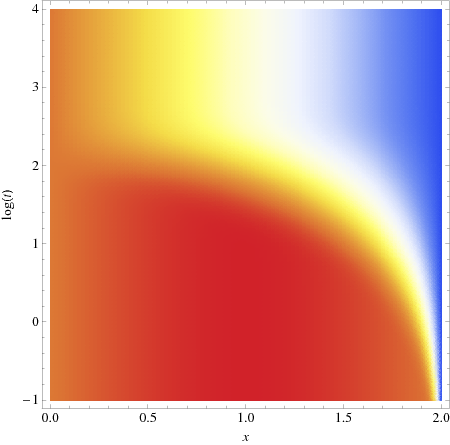
Consider a rod of length 2m, laterally insulated (heat only flows inside the rod). Initially the temperature u is
|
{1\over
k}\mathop{sin}\nolimits \left ({πx\over
2} \right ) + 500\text{ K}.
| (5.48) |
The left and right ends are both attached to a thermostat, and the temperature at the left side is fixed at a temperature of 500\text{ K} and the right end at 100\text{ K}. There is also a heater attached to the rod that adds a constant heat of \mathop{sin}\nolimits \left ({πx\over 2} \right ) to the rod. The differential equation describing this is inhomogeneous
Since the inhomogeneity is time-independent we write
|
u(x,t) = v(x,t) + h(x),
| (5.50) |
where h will be determined so as to make v satisfy a homogeneous equation. Substituting this form, we find
|
{∂v\over
∂t} = k{{∂}^{2}v\over
∂{x}^{2}} + kh'' +\mathop{ sin}\nolimits \left ({πx\over
2} \right ).
| (5.51) |
To make the equation for v homogeneous we require
|
h''(x) = −{1\over
k}\mathop{sin}\nolimits \left ({πx\over
2} \right ),
| (5.52) |
which has the solution
|
h(x) = {C}_{1}x + {C}_{2} + {4\over
k{π}^{2}}\mathop{ sin}\nolimits \left ({πx\over
2} \right ).
| (5.53) |
At the same time we let h carry the boundary conditions, h(0) = 500, h(2) = 100, and thus
|
h(x) = −200x + 500 + {4\over
k{π}^{2}}\mathop{ sin}\nolimits \left ({πx\over
2} \right ).
| (5.54) |
The function v satisfies
This is a problem of a type that we have seen before. By separation of variables we find
|
v(x,t) ={ \mathop{∑
}}_{n=1}^{∞}{b}_{
n}\mathop{ exp}\nolimits (−{{n}^{2}{π}^{2}\over
4} kt)\mathop{sin}\nolimits {nπ\over
2} x.
| (5.56) |
The initial condition gives
|
{\mathop{∑
}}_{n=1}^{∞}{b}_{
n}\mathop{ sin}\nolimits nx = 200x.
| (5.57) |
from which we find
|
{b}_{n} = {(−1)}^{n+1}{800\over
nπ} .
| (5.58) |
And thus
Note: as t →∞, u(x,t) →−{400\over π} x + 500 + {\mathop{sin}\nolimits {π\over 2} x\over k} . As can be seen in Fig. 5.2 this approach is quite rapid – we have chosen k = 1∕500 in that figure, and summed over the first 60 solutions.